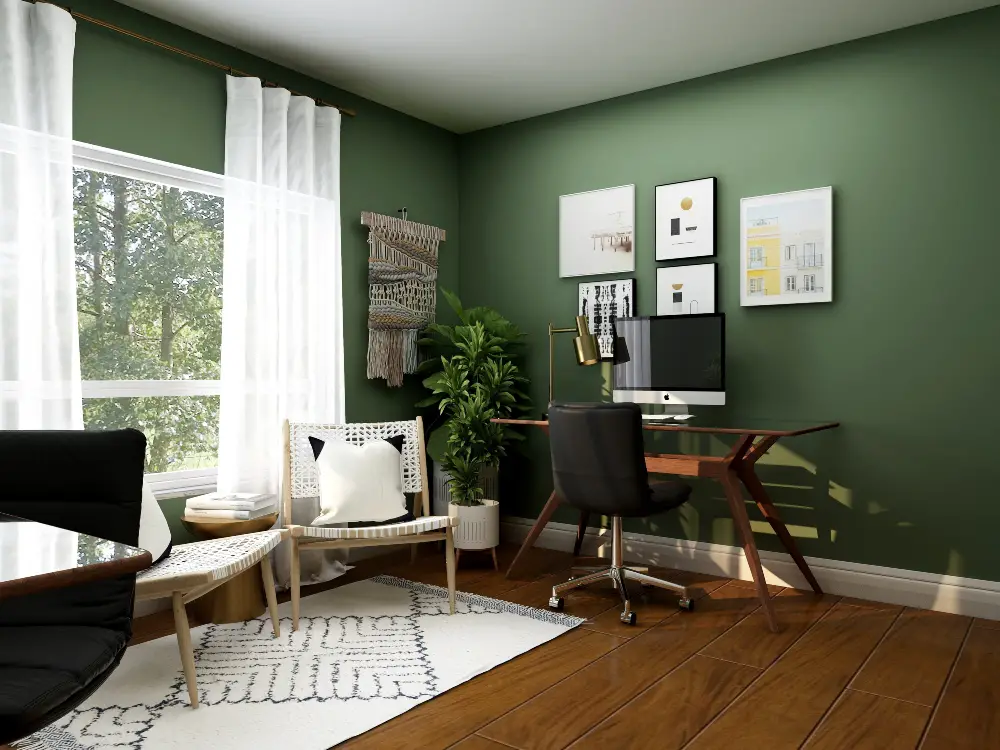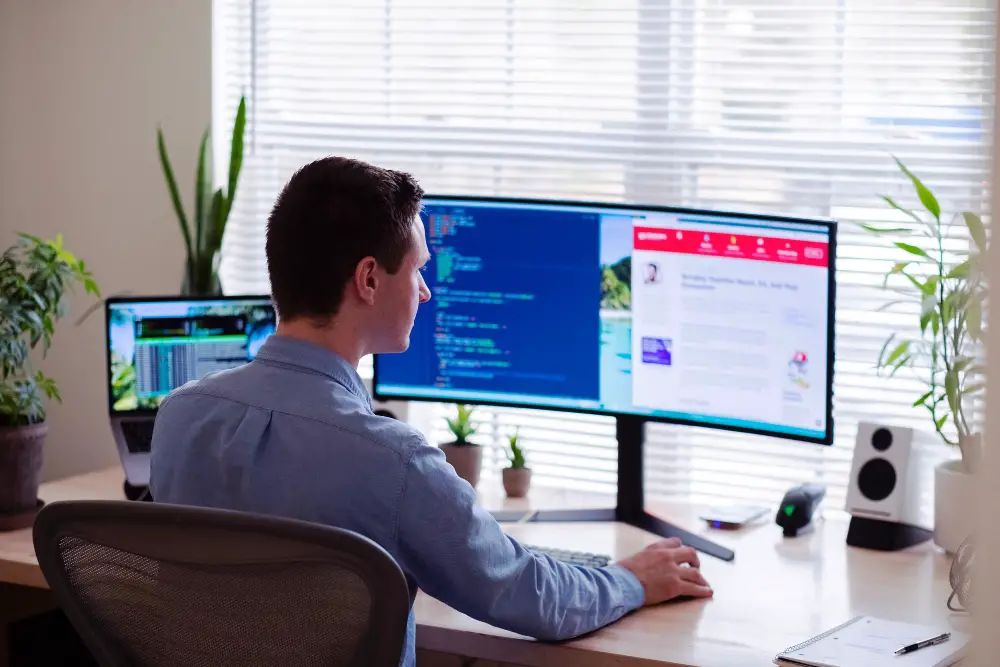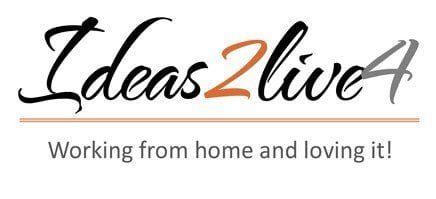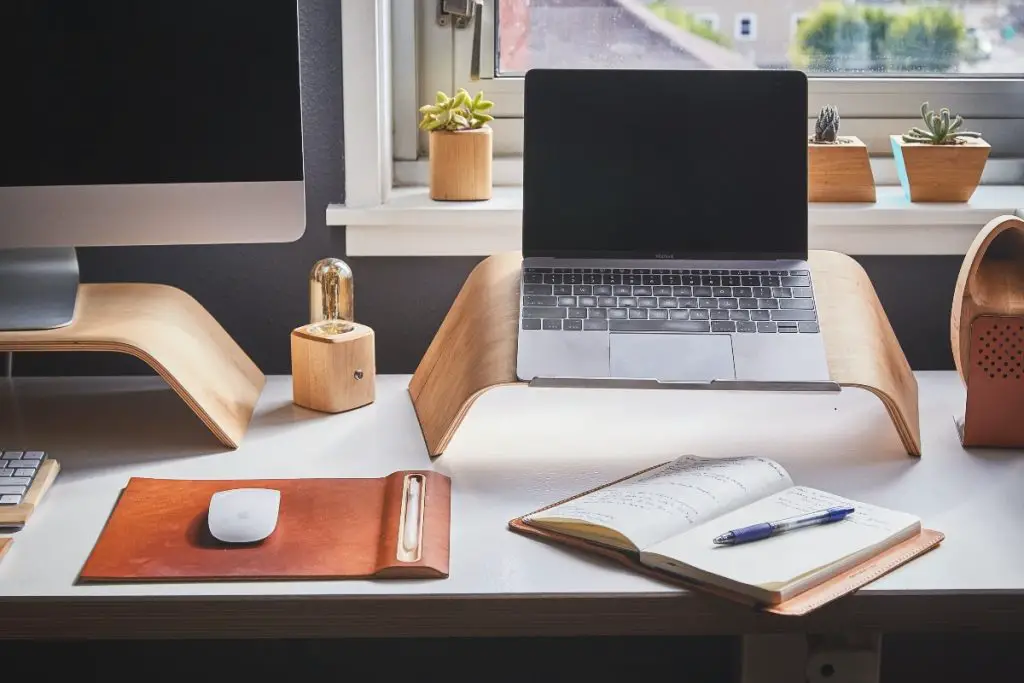Creating a home office that meets your needs is essential for productivity and comfort. This guide will explore critical elements for setting up an ideal workspace. This guide will consider furniture, technology, and personal touches that make a home office functional and inviting.
Post Contents
- 1 Understanding Your Space
- 2 Creating Your Productive Home Office
- 3 Staying Productive and Motivated
- 4 FAQ on Setting Up a Home Office
- 4.1 What are the essentials for a home office?
- 4.2 How can I make my home office ergonomic?
- 4.3 What are the best ways to stay productive in a home office?
- 4.4 How can I manage noise and distractions in my home office?
- 4.5 What should I consider when choosing technology for my home office?
- 4.6 Can personal touches improve my home office?
- 4.7 How important is lighting in a home office?
- 4.8 What are some good health practices for working in a home office?
- 5 Conclusion
Understanding Your Space
Creating an ideal home office begins with understanding and utilizing your available space effectively. This section will guide you through assessing your space and selecting the best location for productivity and comfort.
Assessing the Available Area
Accurately assessing the available area is crucial in setting up your home office. Start by measuring the dimensions of your selected space. This step ensures you choose furniture that fits comfortably without overcrowding the area. Consider the room’s layout, considering where windows and doors are located. The goal is to create a home office that feels open and uncluttered.
When evaluating the space, consider the natural light sources. A room with ample natural light is ideal for a home office, creating a more welcoming and productive environment. However, if natural light is limited, plan for adequate artificial lighting. This approach can transform any corner of your home into a bright and efficient workspace.
Remember, using the available space wisely is the key to a successful home office setup. A well-planned area leads to a comfortable, inviting, and productive home office.
Choosing a Quiet and Well-Lit Location
Selecting the right location within your home is vital to creating an ideal home office. Look for a quiet area to minimize distractions. This might mean choosing a room away from high-traffic areas or soundproofing the space to ensure peace and focus.
Natural light significantly enhances mood and energy levels, making it a desirable feature for your home office. Try to position your desk near a window to benefit from daylight. This improves your wellbeing and reduces the need for artificial lighting during the day.
Invest in quality artificial lighting if your home layout lacks a window-facing desk. A combination of overhead and task lighting, like a desk lamp, can create a bright and inviting atmosphere. Good lighting is not just about visibility; it’s about creating a space where you can work comfortably for long periods.
The location of your home office should balance quietness and good lighting. This combination fosters a productive and comfortable environment crucial for your work-from-home success.
Creating Your Productive Home Office
The key to an ideal home office is the furniture, electronics, and other essentials you place around it. Here are ways you can create a workspace for a superstar employee.
Essential Furniture for Your Home Office
Furnishing your home office is about blending functionality with comfort. The right furniture not only enhances your productivity but also adds to the overall aesthetics of your workspace. This section will cover the key pieces of furniture you need for a well-equipped home office.

Selecting a Comfortable and Ergonomic Chair
When setting up your home office, choosing the right chair is crucial. An ergonomic chair supports long hours of work without discomfort. Here, we’ll explore what makes a chair comfortable and ergonomically sound.
Importance of Ergonomic Design for Posture and Comfort
Ergonomics is about designing for people. An ergonomic chair supports your body in a natural, balanced posture. This design reduces stress on your spine, neck, and hips. It’s essential for preventing pain and discomfort during long work hours. A good chair also promotes better circulation and reduces the risk of muscle fatigue.
Features to Look For
- Adjustability: The best office chairs offer adjustable height, armrests, and tilt tension. This adjustability ensures the chair can be customized to your body shape and desk height.
- Lumbar Support: A chair with good lower back support is vital. It should align with the natural curve of your spine. This feature helps prevent slouching and lessens the strain on your back.
- Seat Material and Padding: Comfort also comes from the seat material and padding. A chair with breathable fabric and adequate cushioning is preferable. It ensures comfort even after sitting for extended periods.
- Swivel and Mobility: A swivel function and smooth-rolling casters add to the chair’s functionality. They allow easy movement around your workspace without strain.
Selecting the right chair for your home office is an investment in your health and productivity. A comfortable, ergonomic chair not only improves your work experience but also your overall well-being.
Finding the Right Desk
Your desk is the centerpiece of your home office. It’s where you’ll spend most of your working hours, so finding the right one is vital. In this section, we’ll look at how to choose a desk that’s both functional and fits well in your space.
Sizing Your Desk According to Your Space and Needs
Measure your available space before choosing a desk. This helps ensure your desk isn’t too large or too small. Think about how you’ll use your desk. You’ll need a more oversized desk if you have multiple monitors or need space for paperwork. For smaller spaces, consider a compact or corner desk.
Considerations for Desk Type
Standing Desks: These are great for ergonomics and keeping you active. Many standing desks are adjustable, allowing you to switch between sitting and standing.
Traditional Desks: These come in various styles and sizes. They’re a good choice if you prefer sitting and need more storage options like drawers and shelves.
Corner Desks: Perfect for maximizing space in smaller rooms. They fit snugly in corners, providing ample workspace without taking up too much room.
Desk Material and Design: The material of your desk affects its look and durability. Wood desks offer a classic feel, while metal or glass desks are more modern. Choose a design that complements your home office’s style.
Choosing a suitable desk for your home office involves considering your space, work needs, and personal style. A well-chosen desk serves your work needs and enhances your productivity and comfort.
Storage Solutions
- Bookshelves are great for organizing books, office supplies, and decorative items. Bookshelves keep things within easy reach and reduce clutter.
- Filing Cabinets: Essential for keeping important documents organized and secure. Opt for cabinets that match your office’s style and offer enough space for your needs.
Accessories and Decor
- Lamps: Adequate lighting is vital. Desk lamps offer focused light for tasks, while floor lamps can illuminate the entire room.
- Organizers: Desk organizers, wall-mounted boards, and drawer dividers help keep your workspace tidy and your mind clear.
- Functional Decor: Add personal touches like plants, artwork, or a comfortable rug. These elements make your home office more inviting and reflect your style.

Technology Must-Haves
In today’s digital age, equipping your home office with the right technology is essential. The right tech tools can significantly enhance your productivity and connectivity from hardware to software. This section will outline the indispensable technological components of a modern home office.
Reliable Computer and High-Speed Internet
Having a reliable computer and high-speed internet is non-negotiable for any home office. These are the backbones of your digital workspace, allowing you to work efficiently and stay connected.
Select a computer that aligns with your professional needs. Opt for a high-performance computer with a powerful processor and superior graphics capabilities if your work involves graphic design or video editing.
A standard desktop or laptop with sufficient processing power and memory should suffice for general office tasks. Also, consider the ergonomics and size of the computer, especially if your home office space is limited.
Importance of a Stable and Fast Internet Connection
A fast and reliable internet connection is crucial in a home office. It ensures smooth video conferencing, quick file uploads, and efficient online research. Invest in a high-quality router and consider upgrading your internet plan for higher bandwidth, especially if you share the network with others at home. For added reliability, have a backup plan like a mobile hotspot in case of internet outages.
Effective Communication Tools
Effective communication is vital in a home office setting. With the right tools, you can maintain clear and professional interactions with colleagues and clients, regardless of physical distance.
A high-quality webcam and microphone are vital for virtual meetings. They ensure you are seen and heard clearly, which is crucial for effective communication. Look for a webcam with good resolution and a microphone that can reduce background noise. This setup will make your video calls more professional and engaging.
Software for Video Conferencing and Online Collaboration
- Video Conferencing Software: Choose a reliable platform for virtual meetings. Software like Zoom, Microsoft Teams, or Google Meet offers various features for effective online communication, including screen sharing and real-time collaboration.
- Collaboration Tools: Utilize online tools that enable seamless collaboration. Platforms like Slack, Asana, or Trello are great for project management and team communication. They help keep everyone on the same page and streamline workflow.
- Email and Instant Messaging: Efficient email management software and instant messaging apps are essential. They offer quick ways to communicate and keep your conversations organized.
Productivity and Security Software
In a home office, the right software can significantly boost your productivity and safeguard your data. This section discusses essential software for efficient work and robust security.
- Task Management Tools: Software like Microsoft To-Do, Trello, or Asana can help organize your tasks and deadlines. They offer features like task lists, reminders, and project tracking.
- Office Suite: A comprehensive office suite is crucial. Programs like Microsoft Office or Google Workspace include word processing, spreadsheets, and presentation tools catering to various tasks.
- Time Management Apps: Tools like RescueTime or Toggl track your work hours and help analyze productivity patterns. They help manage time and stay focused.
- Antivirus and Anti-Malware Software: Protect your computer from viruses, malware, and cyber threats. Reliable antivirus software is a must-have in any home office setup.
- VPN Services: A Virtual Private Network (VPN) ensures secure and private internet connections, especially when handling sensitive information.
- Data Backup Solutions: Regularly back up your work. Cloud storage services like Dropbox or Google Drive offer secure and accessible options. Additionally, consider external hard drives for physical backups.
- Password Managers: A password manager can secure and manage your login credentials, adding an extra layer of security to your online activities.
Auxiliary Devices and Accessories
Equipping your home office with the right auxiliary devices and accessories can enhance your work experience and efficiency. These items complement your primary tech setup and create a more effective and comfortable workspace.
- Printers and Scanners: Even in a digital age, having a printer and scanner is beneficial. Choose a multi-function device that can print, scan, and copy to save space and money.
- External Monitors: An external monitor is a great addition for multitasking and a larger visual workspace. It’s especially useful for graphic design, video editing, or if you frequently work with multiple applications.
- UPS (Uninterruptible Power Supply): Protect your devices from power surges and keep them running during short power outages.
- Ergonomic Keyboard: An ergonomic keyboard can reduce strain on your wrists and hands. Look for one with comfortable key placement and wrist support.
- Ergonomic Mouse: An ergonomic mouse minimizes strain like the keyboard. Consider features like size, grip style, and button placement for comfort.
- Noise-Cancelling Headphones: These are essential in noisy environments, helping you focus by blocking background noise.
- Webcam Covers and Privacy Screens: For added privacy, use webcam covers. Privacy screens for your monitors protect sensitive information from prying eyes.
Sound and Distraction Management
Managing sound and distractions is crucial for maintaining focus in your home office. This section discusses tools and strategies to minimize noise and interruptions, creating a more productive work environment.
- Noise-canceling Headphones: Ideal for blocking out household or external noise. They allow you to concentrate on your tasks without distractions.
- Soundproofing Solutions: Consider soundproofing options like acoustic panels or weatherstripping for doors and windows. These can significantly reduce ambient noise.
- Focus Apps: Apps like Forest or Freedom can help you stay focused by blocking distracting websites and apps for set periods.
- Workspace Layout: Organize your workspace to minimize visual clutter. Keep only essential items on your desk.
- Setting Boundaries: Establish clear boundaries with household members to minimize interruptions during work hours.

Organizational Tools
A well-organized home office is key to efficiency and a clutter-free mind. With the right organizational tools, you can keep your workspace tidy and your tasks in check. This section will outline the essential tools to help you organize your home office effectively.
Physical Organization Solutions
Keeping your home office physically organized is essential for a productive work environment. Let’s explore how to select the right storage solutions and manage your workspace efficiently.
- Choosing Storage Furniture: Consider what items you need to store. Bookshelves are great for books and binders while filing cabinets are ideal for important documents. Ensure the storage furniture fits your space and complements your desk and chair.
- Utilizing Wall Space: Use wall-mounted shelves or cabinets to save floor space. Pegboards or magnetic boards can organize small items and keep them within reach.
- Desk Organizers: Use desk organizers for stationery, papers, and other small items. This keeps your desk clutter-free and ensures everything is easily accessible.
- Cable Management: Cables can create clutter and tripping hazards. Use cable ties, clips, or a cable management box to keep them organized and out of sight.
- Regular Decluttering: Make it a habit to regularly clear out unnecessary items from your desk and storage areas. This keeps your space clean and manageable.
Digital Organization Tools
Effective digital organization is crucial in a modern home office. These tools help manage documents, schedule tasks, and keep your digital workspace as orderly as your physical one. Here’s how to make the most of digital organization tools.
- Cloud Storage: Services like Google Drive or Dropbox are excellent for storing and organizing digital files. They offer easy access from multiple devices and secure backup options.
- Document Management Systems: Consider using specialized software for managing large numbers of documents. These systems often include features for categorization, searchability, and version control.
- Calendar Apps: Digital calendars like Google Calendar or Microsoft Outlook are essential. They help you track appointments, deadlines, and important dates.
- Reminder and To-Do Apps: Apps like Evernote or Todoist allow you to create task lists and set reminders. They help ensure you don’t forget important tasks and deadlines.
- Project Management Tools: Tools like Asana, Trello, or Monday.com can be invaluable for more complex tasks or team projects. They help manage projects, assign tasks, and track progress.
Time Management Techniques
Effective time management is crucial in a home office. It helps you stay productive, meet deadlines, and maintain a healthy work-life balance. Let’s explore some key strategies and tools for managing your time effectively.
- The Eisenhower Matrix: This technique helps categorize tasks by urgency and importance. It lets you focus on what’s essential and avoid wasting time on less critical tasks.
- The Pomodoro Technique: This method involves working in focused bursts (typically 25 minutes) followed by short breaks. It can enhance focus and prevent burnout.
- Setting Clear Goals: Start each day or week by setting clear, achievable goals. This helps direct your efforts and keeps you motivated.
- Time Tracking Apps: Use apps like Toggl or Harvest to track how much time you spend on various tasks. This can provide insights into your work patterns and help improve efficiency.
- Digital Planners: Planners like Google Keep or Notion can help organize your schedule, set reminders, and keep track of your to-do lists.
- Automated Scheduling Tools: Tools like Calendly can automate meeting scheduling. They save time and prevent the back-and-forth often associated with arranging meetings.
Creating a System for Regular Maintenance
Maintaining an organized and efficient home office requires a consistent system for regular upkeep. This system ensures that your workspace remains conducive to productivity and doesn’t become cluttered or disorganized over time. Let’s explore how to establish a routine for maintaining your home office.
- Daily Clean-Up: At the end of each workday, spend a few minutes tidying your desk. File away papers, clear coffee cups, and reset your workspace for the next day.
- Weekly Organizing: Set aside time each week for a more thorough organization. This includes decluttering your desk, checking your digital files, and ensuring everything is in its right place.
- Regularly Review and Update Your System: As your work evolves, so will your organizational needs. Periodically review and adjust your organization system to suit your current workflow.
- Set Reminders: Use digital reminders to prompt your regular maintenance activities. This helps establish the routine until it becomes a habit.
- Keep Organizational Tools Accessible: Ensure all your organizational tools are within easy reach. This makes it more likely that you’ll use them consistently.
- Personalize Your System: Customize your organizational system to match your work style and preferences. A system that feels natural to you is easier to maintain.
Health and Wellbeing
Maintaining health and wellbeing is crucial in a home office setting. This section explores how ergonomic choices, lighting, regular breaks, and personal touches contribute to a healthier and more productive workspace.
Ergonomic Comfort for Physical Health
Ergonomics is key in a home office. A proper chair and desk setup help maintain good posture, reducing the risk of physical strain. The placement of your monitor, keyboard, and mouse should encourage a relaxed posture. Adjusting these elements prevents common issues like neck pain and wrist strain.
Lighting for Eye Health and Concentration
Good lighting is essential. Natural light is ideal, but if unavailable, ensure your workspace is well-lit with ambient lighting. Proper lighting reduces eye strain and headaches, enhancing focus and productivity.
Regular Breaks for Mental Refreshment
Taking breaks is important for mental health. Short breaks throughout the day help reduce eye strain and mental fatigue. Use these moments to stretch, move around, or engage in a brief physical activity. This keeps your body active and mind clear.
Optimal Air Quality and Temperature
The air and room temperature quality in your home office significantly affects your comfort. Good ventilation and a comfortable temperature help maintain focus and prevent discomfort.
Personal Touches for a Positive Atmosphere
Adding personal elements to your home office can uplift your mood. Plants, artwork, or family photos create a pleasant and personalized environment. This makes your home office a space where you’re happy to work.
Focusing on these key aspects, your home office becomes a supportive space for your physical and mental health. These elements are vital for creating a productive and enjoyable work environment.
Staying Productive and Motivated
Maintaining productivity and motivation can be challenging in a home office. This section delves into strategies and practices that help you stay focused and driven, ensuring you make the most of your remote work environment.
Setting Clear Boundaries
One of the first steps to staying productive is setting clear boundaries. Define your work hours and stick to them. This helps separate your professional and personal life, preventing burnout. Inform household members of your work schedule to minimize interruptions. Create a routine that signals the start and end of your workday, like dressing for work or a closing ritual.
Creating a Conducive Work Environment
Your physical workspace greatly influences your productivity. Keep your home office clean, organized, and free from distractions. Invest in comfortable furniture and necessary technology. A well-set-up workspace not only boosts efficiency but also makes work more enjoyable.
Time Management Techniques
Effective time management is key in a home office. Use tools like digital calendars and to-do lists to plan your day. Break your tasks into smaller, manageable chunks and prioritize them. Techniques like the Pomodoro Technique, where you work in focused intervals, can enhance concentration and productivity.
Staying Connected
Working from home can sometimes feel isolating. Stay connected with your colleagues through regular virtual meetings and communications. This not only aids in collaboration but also keeps you engaged and part of the team.
Personal Development and Learning
Continuously seek opportunities for personal development and learning. This could be through online courses, reading, or attending webinars. Expanding your skills and knowledge keeps you motivated and opens new avenues for professional growth.
Regular Exercise and Healthy Habits
Incorporate regular exercise and healthy habits into your routine. Physical activity boosts energy levels and improves mental health. A balanced diet, adequate sleep, and mindfulness practices like meditation can also enhance your wellbeing and work performance.
FAQ on Setting Up a Home Office
What are the essentials for a home office?
The essentials include a comfortable, ergonomic chair, a desk that fits your space and needs, reliable computer and high-speed internet technology, effective lighting, and organizational tools.
How can I make my home office ergonomic?
Invest in an ergonomic chair and desk. Ensure your computer monitor is at eye level, and your arms can comfortably rest on the desk. Use ergonomic keyboards and mice to reduce strain.
What are the best ways to stay productive in a home office?
Stay productive by setting clear work boundaries, organizing your space, managing your time effectively, and taking regular breaks. Staying connected with colleagues and pursuing personal development can also boost productivity.
How can I manage noise and distractions in my home office?
Use noise-cancelling headphones, set up soundproofing solutions like acoustic panels, and establish boundaries with household members. Organizational tools and focus apps can also help manage distractions.
What should I consider when choosing technology for my home office?
Consider your work type and choose the technology that supports it. A reliable computer and high-speed internet are crucial. Also, think about communication tools like a high-quality webcam and microphone.
Can personal touches improve my home office?
Adding personal elements like plants, artwork, or comfortable rugs can make your space more inviting and improve your mood and productivity.
How important is lighting in a home office?
Lighting is very important. It affects your mood and eye health. Natural light is best, but if it’s not available, use a combination of ambient and task lighting to create a well-lit workspace.
What are some good health practices for working in a home office?
Maintain good posture, take regular breaks, exercise, eat healthily, and ensure your workspace is comfortable and well-ventilated. These practices help prevent physical and mental fatigue.
Conclusion
Setting up an ideal home office combines practicality, comfort, and personalization. You create a workspace that boosts productivity and supports your health and happiness by focusing on ergonomic furniture, effective technology, organizational tools, and personal wellbeing.







